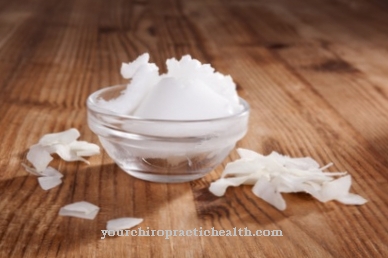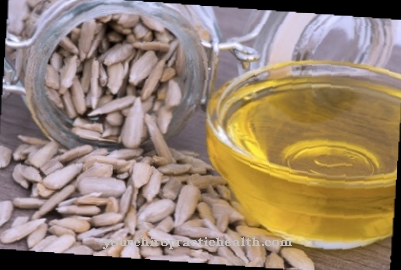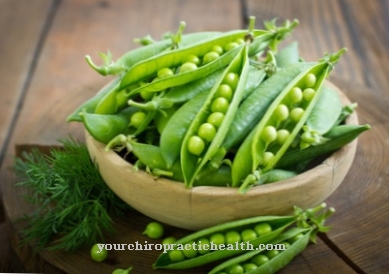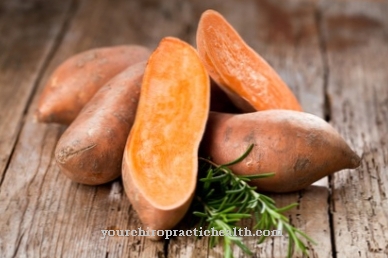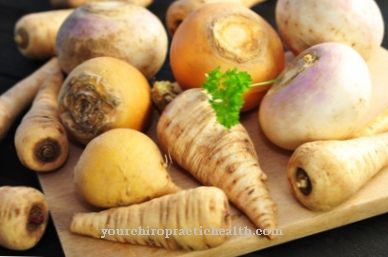It is probably thanks to a sheer coincidence in 1870 that we can now expand our varied menu with a tasty type of salad, especially in the winter months. Chicory - Many people like it because of its tart, slightly bitter taste and appreciate its positive effects on health.
What you should know about chicory

The scientific name for chicory is Cichorium intybus var foliosum. This type of lettuce belongs to the sunflower family and is a descendant of the wild chicory.
Chicory is grown in Europe, North Africa and the Orient. The main producing countries are primarily Belgium, but also France and the Netherlands. As already mentioned at the beginning, it is assumed that chicory was “discovered” by chance. The roots of chicory were already dried, roasted and used as a "coffee substitute" in the 19th century. Belgian farmers hibernated these roots in the earth in 1870, probably because of the high supply. A short time later, it was possible to observe how sprouts germinated from the roots. The chicory head is on average about 15 centimeters long and about 3-5 centimeters thick.
Chicory consists of many small, elongated leaves that are arranged in circles and layers around the stalk. The color of the leaves is slightly whitish to yellowish. Chicory is a wonderful winter vegetable. When it gets too cold for other types of salad, this is the right time for you. This is mainly due to the fact that several different and extraordinary factors play an important role in cultivation. It is harvested from October to April. Chicory must be grown in complete darkness. This prevents the formation of chlorophyll.
In addition, the plant needs a cold stimulus and a special climate to germinate. Chicory has a pleasant bitter and tart note. In addition to the white chicory, there is now also a cross with radicchio, which has produced a milder and reddish colored variety.
Importance to health
Just like all other types of salad, chicory is an indispensable part of every healthy menu. In addition to the positive effects on body weight, this type of salad also has many other properties that promote and support health or alleviate existing complaints.
The most important component is the bitter substance lactucopicrin (formerly also called intybin). It is important for the plant in defending itself against bacteria, fungi and parasites. In a low concentration as in chicory, it has a positive effect on the stomach and intestinal flora. Bitter substances also lower blood sugar and have the property of having an analgesic effect. The stimulating effects of lactucopicrin on the bile and pancreas have the effect of lowering cholesterol levels.
The harmful LDL cholesterol is reduced by up to ten percent. Another important substance is the inulin it contains. This is a soluble fiber that also plays a major role in preventing intestinal diseases (e.g. colon cancer). In addition: Chicory is an excellent anti-aging vegetable because it supports the body in many important functions and in cell renewal in the body. Further effects: diuretic, positive for regulating the acid-base balance, antioxidant by binding free radicals. Low in calories and acid binding, chicory is a wonderful food for rheumatics or diabetics.
Ingredients & nutritional values
The main ingredient in the leaves of chicory is almost 95 percent water. This and its other ingredients make it one of the low-calorie and low-fat salads of our time.
The most important substances in chicory are vitamins A, B, C as well as potassium, phosphorus, calcium and magnesium. Expressed in numbers, this means that for 100 grams of chicory, only 16 calories have to be counted. It also contains 1.2 g protein and 0.3 g fat. The bitter and fiber in chicory has already been discussed in more detail in the section on health.
Intolerances & allergies
Intolerance to chicory can occur if people have an allergic reaction to the daisy family. Research has also shown that so-called cross allergies can occur. Possible cross-reactions can occur with a birch pollen allergy or an allergy to mugwort.
If you are allergic to one of the two substances mentioned, you should also be tested for intolerance to chicory. Symptoms of a cross allergy are similar to those of a sunflower allergy. Fatigue, cardiovascular disorders, headaches and digestive tract discomfort are just some of the most common signs. Unfortunately, the only thing that helps here is consistently avoiding food.
Shopping & kitchen tips
When buying chicory, the following should be considered. A sign of quality is a flawless appearance. The outer leaves should not have any brown spots. The color of the leaves is pale whitish to yellowish in fresh produce.
A strong green color is a sign of a high proportion of bitter substances. The size is chosen depending on the desire and type of use. Larger forms are good for fillings and for gratinating. Small ones are good for salads and as a side dish for stewing vegetables. When storing, it should be noted that the chicory should also be stored in a cool place, protected from light, due to the way it is grown. Uncut and possibly wrapped in a damp cloth, the salad can be kept in the refrigerator's vegetable compartment for up to four days.
The earlier the chicory is consumed, the more healthy ingredients it contains. The preparation is simple and straightforward. The chicory comes into little contact with sand or earth during cultivation, so it hardly needs to be cleaned. It is enough if it is rinsed off briefly. If you don't like the bitter substances, you can soak the chicory in lukewarm water for a few minutes. Another method is to cut the lettuce in half and generously cut out the middle part (stalk). This contains most of the bitter substances.
Preparation tips
The most important thing to note when preparing chicory is the choice of container. Under no circumstances should pots and bowls made of iron or aluminum be used. As a result, the chicory turns black. Chicory is an excellent accompaniment to hearty winter dishes, such as duck or goose. The vegetable variety harmonizes perfectly with citrus fruits such as mandarins or oranges as well as other winter salads such as lamb's lettuce.
Cut and briefly steamed in broth or a little butter, chicory becomes a modern vegetable side dish. In order for the leaves to keep their color, a little lemon juice is added when steaming. Chicory can also be baked well. Cheeses like Gouda and Emmentaler go well with these winter vegetables.

